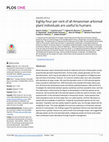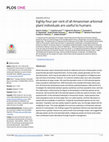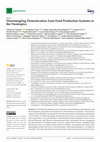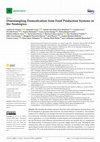Historical Ecology by Sara Deambrozi Coelho

PLoS ONE, 2021
Plants have been used in Amazonian forests for millennia and some of these plants are disproporti... more Plants have been used in Amazonian forests for millennia and some of these plants are disproportionally abundant (hyperdominant). At local scales, people generally use the most abundant plants, which may be abundant as the result of management of indigenous peoples and local communities. However, it is unknown whether plant use is also associated with abundance at larger scales. We used the population sizes of 4,454 arboreal species (trees and palms) estimated from 1946 forest plots and compiled information about uses from 29 Amazonian ethnobotany books and articles published between 1926 and 2013 to investigate the relationship between species usefulness and their population sizes, and how this relationship is influenced by the degree of domestication of arboreal species across Amazonia. We found that half of the arboreal species (2,253) are useful to humans, which represents 84% of the estimated individuals in Amazonian forests. Useful species have mean populations sizes six times larger than non-useful species, and their abundance is related with the probability of usefulness. Incipiently domesticated species are the most abundant. Population size was weakly related to specific uses, but strongly related with the multiplicity of uses. This study highlights the enormous usefulness of Amazonian arboreal species for local peoples. Our findings support the hypothesis that the most abundant plant species have a greater chance to be useful at both local and larger scales, and suggest that although people use the most abundant plants, indigenous people and local communities have contributed to plant abundance through long-term management.

In this chapter, the reader will find guidelines and suggestions for the application of ethnobota... more In this chapter, the reader will find guidelines and suggestions for the application of ethnobotanical and ethnoecological methods in archaeological sites and their surroundings, aiming to establish a closer dialogue between ethnobiology and archaeology for understanding the human history of past and present landscapes. The goal of such methodological proposals is to document the knowledge and practices of human populations that live on and around archaeological sites concerning the vegetation of these areas. The methods presented here can shed light on specific questions about the relationships between past human populations and their plant resources (e.g., practices of use, management, and domestication), helping to understand how people transformed the landscape and how the legacies of such relationships are visible in the present. This chapter is collectively written by ethnobiologists, botanists, ecologists, and archaeologists from several institutions working in the Amazon basin. Thus, examples presented here come mainly from research conducted in this region.
Papers by Sara Deambrozi Coelho

Springer Protocols Handbooks, 2018
In this chapter, the reader will find guidelines and suggestions for the application of ethnobota... more In this chapter, the reader will find guidelines and suggestions for the application of ethnobotanical and ethnoecological methods in archaeological sites and their surroundings, aiming to establish a closer dialogue between ethnobiology and archaeology for understanding the human history of past and present landscapes. The goal of such methodological proposals is to document the knowledge and practices of human populations that live on and around archaeological sites concerning the vegetation of these areas. The methods presented here can shed light on specific questions about the relationships between past human populations and their plant resources (e.g., practices of use, management, and domestication), helping to understand how people transformed the landscape and how the legacies of such relationships are visible in the present. This chapter is collectively written by ethnobiologists, botanists, ecologists, and archaeologists from several institutions working in the Amazon basin. Thus, examples presented here come mainly from research conducted in this region.

PLOS ONE, 2021
Plants have been used in Amazonian forests for millennia and some of these plants are disproporti... more Plants have been used in Amazonian forests for millennia and some of these plants are disproportionally abundant (hyperdominant). At local scales, people generally use the most abundant plants, which may be abundant as the result of management of indigenous peoples and local communities. However, it is unknown whether plant use is also associated with abundance at larger scales. We used the population sizes of 4,454 arboreal species (trees and palms) estimated from 1946 forest plots and compiled information about uses from 29 Amazonian ethnobotany books and articles published between 1926 and 2013 to investigate the relationship between species usefulness and their population sizes, and how this relationship is influenced by the degree of domestication of arboreal species across Amazonia. We found that half of the arboreal species (2,253) are useful to humans, which represents 84% of the estimated individuals in Amazonian forests. Useful species have mean populations sizes six times...

Quaternary, 2021
The Neolithic Revolution narrative associates early-mid Holocene domestications with the developm... more The Neolithic Revolution narrative associates early-mid Holocene domestications with the development of agriculture that fueled the rise of late Holocene civilizations. This narrative continues to be influential, even though it has been deconstructed by archaeologists and geneticists in its homeland. To further disentangle domestication from reliance on food production systems, such as agriculture, we revisit definitions of domestication and food production systems, review the late Pleistocene–early Holocene archaeobotanical record, and quantify the use, management and domestication of Neotropical plants to provide insights about the past. Neotropical plant domestication relies on common human behaviors (selection, accumulation and caring) within agroecological systems that focus on individual plants, rather than populations—as is typical of agriculture. The early archaeobotanical record includes numerous perennial and annual species, many of which later became domesticated. Some of...

Agroforestry Systems
The Serra do Brigadeiro State Park (PESB) is one of the largest fragments of Brazilian Atlantic R... more The Serra do Brigadeiro State Park (PESB) is one of the largest fragments of Brazilian Atlantic Rainforest, and it is relevant for native species conservation. However, monocultures settled around the Park resulted in extensive open areas that facilitate the establishment of alien species on the PESB perimeter, which may threaten native species conservation therein, since biological invasion is the second main cause of global biodiversity loss. In this region, there are also farmers planting agroforestry systems (AFS), characterized by tree-based intercropping, which are structurally more similar to the Atlantic Rainforest reminiscent fragments present in the region and may limit local occurrence of potentially invasive exotic weeds for several reasons, such as the high levels of shade provided by trees, the groundcover that result from loss of tree leaves and the increased competition for belowground resources. This study aimed to test whether AFS limit exotic species establishment when compared to monoculture systems. Accordingly, three coffee monocultures and three agroforestry coffee plantations around the PESB were studied. In each of the six study areas, 30 plots of 1 m2 were established between the lines of coffee plantation, where all species present were surveyed. In both treatments, rarefaction curves were constructed to evaluate native and exotic richness, and diversity of these two categories was estimated through Simpson index inverse (1/D). All 13 sampled exotic species were present in monocultures, but only three of them occurred in AFS. Besides, alien diversity in monocultures ($$1/D$$1/D = 2.173 ± 0.011) was significantly higher than in AFS ($$1/D$$1/D = 1.031 ± 0.001). Such changes in alien plant community between land-use show that AFSs limit invasive species establishment. Therefore, when planted around protected areas, AFS may contribute to the control of biological invasions and to biodiversity conservation.

Quaternary, 2021
The Neolithic Revolution narrative associates early-mid Holocene domestications with the developm... more The Neolithic Revolution narrative associates early-mid Holocene domestications with the development of agriculture that fueled the rise of late Holocene civilizations. This narrative continues to be influential, even though it has been deconstructed by archaeologists and geneticists in its homeland. To further disentangle domestication from reliance on food production systems, such as agriculture, we revisit definitions of domestication and food production systems, review the late Pleistocene–early Holocene archaeobotanical record, and quantify the use, management and domestication of Neotropical plants to provide insights about the past. Neotropical plant do-mestication relies on common human behaviors (selection, accumulation and caring) within agroecological systems that focus on individual plants, rather than populations—as is typical of agriculture. The early archaeobotanical record includes numerous perennial and annual species, many of which later became domesticated. Some o...









Uploads
Historical Ecology by Sara Deambrozi Coelho
Papers by Sara Deambrozi Coelho